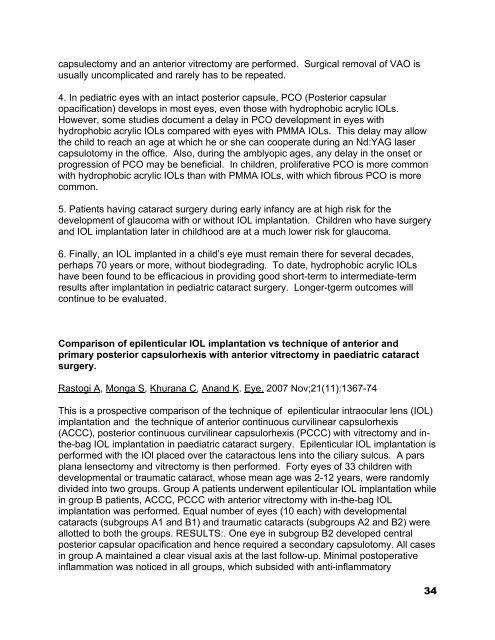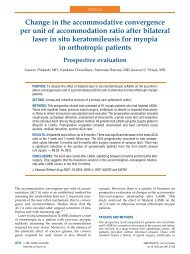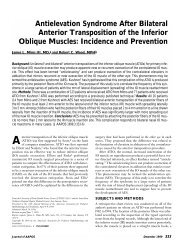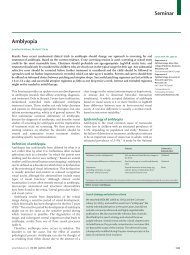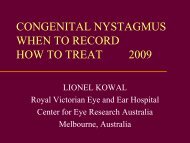What's new AAPOS 2008 - The Private Eye Clinic
What's new AAPOS 2008 - The Private Eye Clinic
What's new AAPOS 2008 - The Private Eye Clinic
You also want an ePaper? Increase the reach of your titles
YUMPU automatically turns print PDFs into web optimized ePapers that Google loves.
capsulectomy and an anterior vitrectomy are performed. Surgical removal of VAO is<br />
usually uncomplicated and rarely has to be repeated.<br />
4. In pediatric eyes with an intact posterior capsule, PCO (Posterior capsular<br />
opacification) develops in most eyes, even those with hydrophobic acrylic IOLs.<br />
However, some studies document a delay in PCO development in eyes with<br />
hydrophobic acrylic IOLs compared with eyes with PMMA IOLs. This delay may allow<br />
the child to reach an age at which he or she can cooperate during an Nd:YAG laser<br />
capsulotomy in the office. Also, during the amblyopic ages, any delay in the onset or<br />
progression of PCO may be beneficial. In children, proliferative PCO is more common<br />
with hydrophobic acrylic IOLs than with PMMA IOLs, with which fibrous PCO is more<br />
common.<br />
5. Patients having cataract surgery during early infancy are at high risk for the<br />
development of glaucoma with or without IOL implantation. Children who have surgery<br />
and IOL implantation later in childhood are at a much lower risk for glaucoma.<br />
6. Finally, an IOL implanted in a child’s eye must remain there for several decades,<br />
perhaps 70 years or more, without biodegrading. To date, hydrophobic acrylic IOLs<br />
have been found to be efficacious in providing good short-term to intermediate-term<br />
results after implantation in pediatric cataract surgery. Longer-tgerm outcomes will<br />
continue to be evaluated.<br />
Comparison of epilenticular IOL implantation vs technique of anterior and<br />
primary posterior capsulorhexis with anterior vitrectomy in paediatric cataract<br />
surgery.<br />
Rastogi A, Monga S, Khurana C, Anand K. <strong>Eye</strong>. 2007 Nov;21(11):1367-74<br />
This is a prospective comparison of the technique of epilenticular intraocular lens (IOL)<br />
implantation and the technique of anterior continuous curvilinear capsulorhexis<br />
(ACCC), posterior continuous curvilinear capsulorhexis (PCCC) with vitrectomy and inthe-bag<br />
IOL implantation in paediatric cataract surgery. Epilenticular IOL implantation is<br />
performed with the IOl placed over the cataractous lens into the ciliary sulcus. A pars<br />
plana lensectomy and vitrectomy is then performed. Forty eyes of 33 children with<br />
developmental or traumatic cataract, whose mean age was 2-12 years, were randomly<br />
divided into two groups. Group A patients underwent epilenticular IOL implantation while<br />
in group B patients, ACCC, PCCC with anterior vitrectomy with in-the-bag IOL<br />
implantation was performed. Equal number of eyes (10 each) with developmental<br />
cataracts (subgroups A1 and B1) and traumatic cataracts (subgroups A2 and B2) were<br />
allotted to both the groups. RESULTS:. One eye in subgroup B2 developed central<br />
posterior capsular opacification and hence required a secondary capsulotomy. All cases<br />
in group A maintained a clear visual axis at the last follow-up. Minimal postoperative<br />
inflammation was noticed in all groups, which subsided with anti-inflammatory<br />
34


